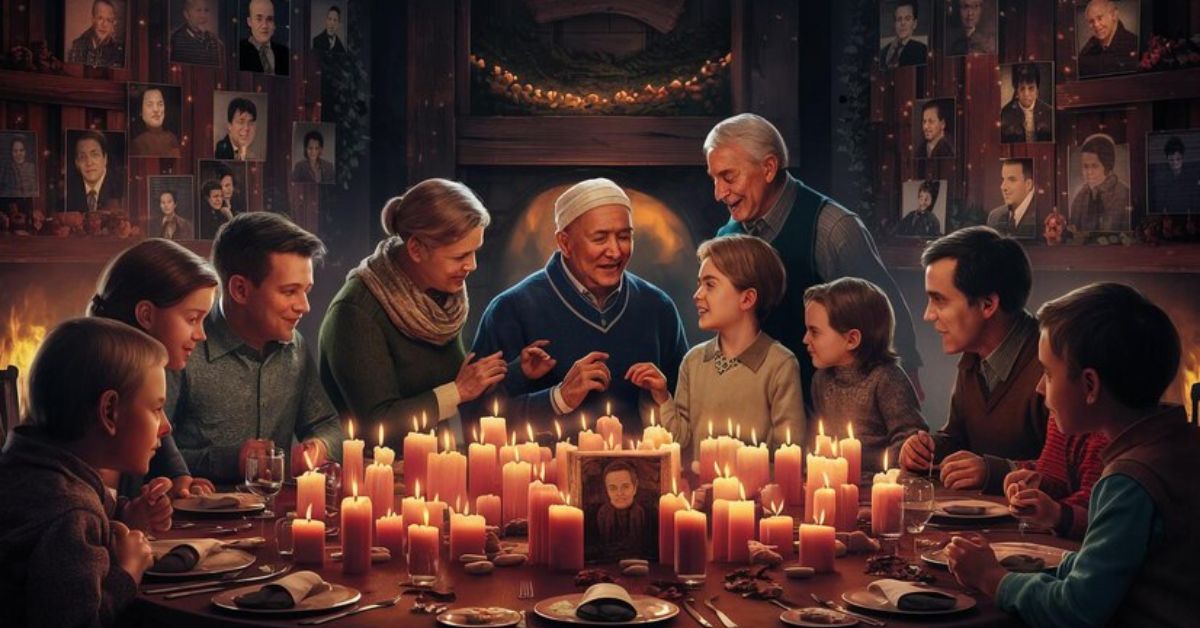General
Setting the Perfect Holiday Table W101 for a Memorable Feast

The holiday season brings with it the joy of gathering around a beautifully set table to share meals, laughter, and cherished moments. Whether you’re hosting a family dinner, a festive brunch, or a more intimate holiday gathering, setting the perfect holiday table is key to creating a welcoming and celebratory atmosphere. In this guide, we’ll break down everything you need to know to create a stunning Holiday Table W101 that elevates your festive celebrations.
What is a Holiday Table W101?
A holiday table refers to the carefully arranged dining space for special occasions like Christmas, Thanksgiving, New Year’s Eve, or any seasonal festivity. It’s not just about the food—it’s about creating an atmosphere that brings people together, making them feel welcome, and setting the mood for an enjoyable gathering. The table setting becomes the heart of your holiday celebration, where friends and family connect and celebrate the season.
You Might Also Like: The Ultimate Guide to Choosing and Customizing a Pink Golf Cart
Why a Beautifully Set Table Matters
The way you set your holiday table can significantly influence the ambiance of your event. A well-decorated table shows attention to detail and effort, making guests feel appreciated and enhancing the overall experience. It reflects the tone of the gathering, whether it’s elegant and formal or cozy and casual. A beautiful table encourages conversation, makes the meal more enjoyable, and helps you create lasting memories.
Essential Elements of a Holiday Table Setup
Setting the perfect holiday table requires careful attention to a few essential elements. Let’s break down the key components that will make your table look spectacular.
1. Choosing the Right Tableware
Your choice of tableware is the foundation of any holiday table. Start by selecting plates, glasses, and utensils that align with the occasion. For example, gold-rimmed plates might be perfect for a formal Christmas dinner, while rustic plates work better for a casual Thanksgiving brunch.
- Plates: Opt for large dinner plates as the main course dishware and smaller side plates or salad plates.
- Glasses: Make sure you have a variety of glasses for water, wine, or cocktails.
- Cutlery: Select appropriate forks, knives, and spoons. Arrange them based on the courses you’ll serve, from the outside in.
2. Table Linens: Adding Texture and Color
Table linens—such as tablecloths, runners, and napkins—add texture and color to your setting. A beautiful tablecloth or runner can bring the entire table together. For a more formal touch, consider white or cream-colored linen. For a bolder look, go for festive reds, greens, or metallic accents.
- Tablecloth: Choose a fabric that suits the season and your desired aesthetic.
- Napkins: Cloth napkins are a great way to elevate the table setting. You can fold them elegantly or even incorporate napkin rings for a polished look.
3. Centerpieces: The Showpiece of the Table
A centerpiece is often the focal point of the table, capturing attention as guests enter the room. It sets the theme for the holiday and adds a touch of elegance or warmth to the meal.
- Traditional Centerpieces: Flowers, candles, or even seasonal fruits like apples and pinecones can serve as a beautiful and festive centerpiece.
- Candlelight: Adding candles not only creates an intimate, cozy ambiance but also highlights the beauty of your table.
- Seasonal Elements: Think of incorporating pine branches, poinsettias, or even a miniature Christmas tree to tie into the holiday spirit.
Creating a Holiday Table Atmosphere
The visual appeal of your holiday table is essential, but the atmosphere is equally important. It’s about striking the right balance between comfort, style, and function. Here’s how to create an atmosphere that enhances your meal:
1. Lighting: Setting the Mood
Lighting plays a crucial role in creating a warm, inviting holiday atmosphere. The right lighting can completely change the mood of your event, adding a cozy, magical glow that enhances the holiday experience.
- Candles: Opt for scented or unscented candles placed throughout the room or along the table.
- Fairy Lights: String lights draped across the table or around the room can add a touch of festive charm.
- Dim the Overhead Lights: Keep the room dimly lit to highlight your table and create a relaxed environment.
2. Personal Touches: Adding Meaning and Warmth
Incorporating personalized touches into your holiday table adds a special meaning to the celebration. These small details will not only delight your guests but also create a memorable experience.
- Place Cards: Customize place cards for each guest, perhaps with a handwritten note or small holiday greeting.
- Small Favors: Little gifts, such as chocolate truffles or holiday ornaments, can be placed at each setting as a thoughtful gesture.
- Holiday-Themed Decor: Whether it’s a subtle accent like a wreath or a fun decoration like Santa figurines, these little touches bring personality to the table.
Practical Tips for Setting Your Holiday Table
While aesthetics are important, there are practical considerations when setting your table for the holidays. These tips will ensure your table looks great and functions well throughout the meal:
1. How to Set the Table Properly
Knowing how to properly set a table can help your holiday gathering feel more polished. Here’s the standard layout for a formal setting:
- From left to right: Start by placing the napkin to the left of the plate, the fork next to the napkin, and the knife to the right of the plate. The spoon should go to the right of the knife.
- Above the Plate: A dessert spoon or fork goes horizontally above the plate.
- Wine Glasses: Place them to the right of the plate, above the knife.
2. Maintain Flexibility for Casual Gatherings
Not all holiday gatherings need a formal setting. If you’re hosting a casual meal or a buffet-style dinner, keep the setup functional and easy. A less rigid arrangement, like a simple centerpiece and minimal cutlery, might be more appropriate.
Seasonal Themes for Holiday Table Decor
Your holiday table can reflect the specific celebration you’re hosting. Here are some seasonal themes you can choose from to make your table shine:
1. Classic Winter Wonderland
Create a magical atmosphere with a snowy, winter-inspired theme. Use white, silver, and blue colors, and incorporate snowflakes, frosted pinecones, and crystal ornaments.
2. Cozy Rustic Holiday
If you’re aiming for a more casual or rustic vibe, consider a wood and greenery theme. Think of natural elements like burlap table runners, pinecones, wooden chargers, and candles.
3. Festive and Fun: A Christmas Feast
For a traditional Christmas look, embrace red, green, gold, and metallics. Add in holiday-themed napkin rings, a Christmas tree centerpiece, and a touch of tinsel.
Conclusion
Setting the Holiday Table W101 is about more than just the decor—it’s about creating an atmosphere of warmth, celebration, and togetherness. By paying attention to the details—from tableware and linens to centerpieces and lighting—you can craft a memorable dining experience for your guests. With these tips, your holiday table will be the heart of your celebration, inviting everyone to sit down, relax, and enjoy the special moments you’ve prepared for them.
General
Coelocaliente: A Rising Gem of Flavorful Cuisine

Coelocaliente is an emerging culinary trend blending traditional flavors with innovative techniques. Rooted in Latin American cuisine, it offers a fiery twist that excites taste buds and elevates dining experiences. From sizzling spices to bold textures, Coelocaliente is a celebration of culinary artistry.
The Origin of Coelocaliente
Coelocaliente draws inspiration from Latin American culinary traditions, emphasizing bold flavors, fresh ingredients, and dynamic presentations. The name itself combines “caliente,” meaning hot, with “coelo,” suggesting harmony and creativity. This fusion embodies the essence of the cuisine: heat, passion, and balance.
Key Features of Coelocaliente Cuisine
1. Spice and Heat
Coelocaliente isn’t just about heat; it’s about layering spices to create complexity. Expect chili-infused sauces, smoky marinades, and fiery rubs.
2. Fresh, Local Ingredients
At its heart, Coelocaliente emphasizes using fresh, seasonal ingredients. Think ripe tomatoes, zesty limes, aromatic herbs, and locally sourced proteins.
3. Fusion of Textures
Crunchy tostadas, tender meats, and creamy sauces create an exciting interplay of textures in every dish.
4. Vibrant Presentation
The visual appeal of Coelocaliente dishes is as important as the taste. Bright colors and artistic plating make the cuisine Instagram-worthy.
Popular Coelocaliente Dishes
1. Spicy Tamarind Shrimp Tacos
These tacos feature succulent shrimp marinated in a tamarind-chili glaze, served on warm corn tortillas with fresh slaw.
2. Smoky Chipotle Chicken
Slow-cooked chicken with a rich, smoky chipotle sauce, served alongside rice and grilled vegetables.
3. Fire-Roasted Salsa Verde Nachos
Tortilla chips topped with a fiery salsa verde, melted cheese, and a sprinkle of fresh cilantro.
4. Chili-Lime Grilled Corn
Juicy corn on the cob brushed with chili-lime butter and garnished with crumbled cheese.
The Coelocaliente Experience
Dining Coelocaliente-style is about more than just food—it’s an immersive experience. Restaurants and chefs often incorporate live cooking demonstrations, music, and cultural storytelling into their presentations.
Why Coelocaliente Is Gaining Popularity
A Unique Flavor Profile
The bold and dynamic flavors of Coelocaliente offer a refreshing alternative to more subdued cuisines.
Cultural Connection
As people seek more authentic dining experiences, Coelocaliente’s deep roots in Latin American culture resonate strongly.
Visual Appeal
The vibrant, colorful dishes are perfect for sharing on social media, boosting its popularity among food enthusiasts.
Health-Conscious Options
With its emphasis on fresh, natural ingredients, Coelocaliente provides a flavorful option for health-conscious diners.
Cooking Coelocaliente at Home
Essential Ingredients
- Dried chilies (ancho, guajillo, chipotle)
- Fresh citrus (lime, orange)
- Herbs like cilantro and oregano
- Garlic and onions for aromatics
Basic Techniques
- Toast chilies to bring out their flavor.
- Create homemade marinades and salsas for depth.
- Experiment with grilling, roasting, and slow-cooking to develop rich tastes.
Easy Recipe: Coelocaliente Chicken Skewers
- Marinate chicken chunks in a mix of lime juice, chili powder, garlic, and olive oil.
- Skewer and grill until lightly charred.
- Serve with a side of spicy mango salsa.
Where to Find Coelocaliente Cuisine
Local Restaurants
Seek out Latin American eateries or fusion restaurants offering Coelocaliente-inspired dishes.
Food Festivals
Many food festivals feature Coelocaliente stands, showcasing the best of this emerging cuisine.
Home Delivery Services
Some platforms now offer Coelocaliente meal kits, allowing you to enjoy the experience from the comfort of your home.
Conclusion
Coelocaliente is more than just a culinary trend—it’s a movement that celebrates culture, creativity, and the joy of food. Whether you’re dining out or experimenting in your kitchen, this fiery cuisine promises a flavorful adventure that leaves a lasting impression.
FAQs
What makes Coelocaliente unique?
The combination of bold spices, fresh ingredients, and vibrant presentation sets it apart.
Is Coelocaliente always spicy?
While spice is a hallmark, the heat level can be adjusted to suit individual preferences.
Can I find vegetarian options in Coelocaliente cuisine?
Absolutely! Grilled vegetables, bean-based dishes, and fresh salsas are popular vegetarian-friendly options.
What drinks pair well with Coelocaliente dishes?
Citrusy cocktails like margaritas, or refreshing aguas frescas, complement the flavors perfectly.
How can I start cooking Coelocaliente dishes at home?
Begin with basic ingredients like chilies, lime, and fresh herbs. Experiment with simple recipes to develop your skills.
General
The Evolution of Insanony in the Digital Era
General
Watchmenontheall Calvin: A Deep Dive into Its Meaning

The term “Watchmenontheall Calvin” might appear unfamiliar to many at first glance. However, it holds deep roots, whether in theological concepts, metaphorical representation, or cultural perspectives. The word “watchmen” has historically represented those who stand guard—whether physically, morally, or spiritually. Adding “Calvin” brings us into a discussion that may touch on theology, particularly referencing John Calvin, a pivotal figure in the Protestant Reformation.
This article delves into the nuances behind the phrase “Watchmenontheall Calvin,” exploring its roots, historical significance, and metaphorical meaning.
Understanding the Concept of Watchmen
The concept of “watchmen” originates in ancient societies where watchmen were designated to stand on city walls, watching for enemies or any threats that could endanger the safety of their people. This imagery extends far beyond its literal meaning; it has taken on spiritual, moral, and philosophical implications over centuries.
In biblical literature, watchmen often appear as symbolic figures who are tasked with remaining alert and warning others of approaching danger. The term became a metaphor for spiritual vigilance, moral guardianship, and divine duty. For example, in Ezekiel 33:7, the prophet is described as a watchman for the house of Israel, responsible for warning people of their sins.
Modern interpretations still hold onto this symbolic weight. Watchmen can represent leaders, preachers, or even individuals who feel a responsibility to protect and guide their communities, spiritually or otherwise.
The Role of John Calvin in Theology
To understand the reference to “Calvin,” it’s important to explore the contributions of John Calvin, a towering figure in Reformed theology during the 16th century. Calvin was instrumental in shaping Protestant thought, emphasizing doctrines such as predestination, the sovereignty of God, and the importance of Scripture.
Calvin’s views on moral accountability and spiritual responsibility align closely with the metaphor of watchmen. Leaders in the church and society, in his teachings, are often seen as guardians of truth who must remain vigilant and guide their congregations toward righteousness.
In Calvinism:
- The Responsibility of Leaders: Calvin taught that church leaders had an immense responsibility to guide their flock, much like watchmen overseeing a city’s safety.
- Vigilance in Faith: Calvin emphasized the need for Christians to remain vigilant in their faith and continuously strive for holiness.
- Accountability to God: Watchmen, in Calvin’s framework, would ultimately answer to God for how they fulfilled their duties.
Thus, “Watchmenontheall Calvin” could reflect the Calvinist idea of spiritual leaders acting as watchmen who warn and guide others toward salvation.
Watchmen as Modern Guardians
Fast forward to the modern era, and the idea of “watchmen” remains relevant. Whether in religious contexts, societal roles, or personal endeavors, being a watchman entails a commitment to vigilance, awareness, and responsibility. Leaders in various spheres—teachers, parents, mentors, and spiritual guides—serve as watchmen in their respective roles.
- Religious Leaders as Watchmen:
Many pastors, preachers, and theologians today see themselves as spiritual watchmen. Inspired by biblical teachings and Calvinist principles, they feel called to warn their congregations against sin and encourage lives of righteousness. - Societal Watchmen:
Beyond the church, watchmen can be seen as individuals who take a stand for justice, morality, and truth. Journalists, activists, and educators often assume the role of modern-day watchmen, warning society about issues such as corruption, injustice, and inequality. - Personal Watchmen:
On a personal level, every individual can become a watchman over their own actions, thoughts, and spiritual life. Calvinist teachings emphasize that Christians should remain self-aware and guard against straying from their faith.
Calvinist Influence on Modern Christianity
The influence of John Calvin extends far beyond the Reformation era. His teachings remain integral to many denominations, including the Presbyterian, Reformed Baptist, and other Calvinist-influenced traditions. Within these communities, the idea of watchmen holds significant weight.
- The Role of Elders and Pastors: Calvinist church leaders see themselves as spiritual overseers who are responsible for their congregation’s spiritual growth and moral accountability. This mirrors the biblical watchmen who were tasked with warning the people of impending danger.
- The Call for Spiritual Readiness: Calvin emphasized a life of discipline, prayer, and Scripture study. For modern Christians, this serves as a reminder to remain spiritually prepared, much like watchmen who remain awake and alert through the night.
- Guarding Against False Teachings: Calvin’s emphasis on the authority of Scripture also calls Christians to guard against false teachings. The idea of watchmen aligns with this need to discern truth from error in spiritual matters.
Metaphorical Representation of Watchmenontheall Calvin
The phrase “Watchmenontheall Calvin” can be interpreted metaphorically to highlight the importance of awareness, vigilance, and responsibility in all aspects of life. Here are some ways to understand its symbolic significance:
- Moral Vigilance: Just as ancient watchmen protected their cities, individuals must guard their moral integrity. This requires standing firm in one’s beliefs and values, even in the face of challenges.
- Spiritual Readiness: Drawing from Calvin’s teachings, Christians are reminded to remain spiritually ready. This involves consistent prayer, study of Scripture, and a deepening of faith.
- Guarding Against Complacency: Watchmen are characterized by their alertness. Metaphorically, this calls individuals to resist complacency and continuously strive for personal growth and societal improvement.
- Guiding Others: Being a watchman also involves helping others recognize the dangers around them, whether spiritual, moral, or societal. Leaders and mentors take on this role as they guide others toward truth and safety.
The Importance of Vigilance in Today’s World
The concept of vigilance remains crucial in today’s fast-paced and complex society. From spiritual guidance to societal leadership, the need for watchmen has never been more evident.
- Protecting Truth: In an age of misinformation and conflicting ideologies, individuals must stand as watchmen for truth and integrity. This includes discerning what is right and sharing that knowledge with others.
- Moral Leadership: Whether in families, schools, or churches, moral leaders act as watchmen who guide others toward ethical living. Their role is to encourage accountability and inspire others to make positive choices.
- Personal Accountability: Beyond guiding others, individuals must also be watchmen over their own actions. Self-awareness, reflection, and personal growth are essential to fulfilling this role.
- Community Watchmen: In communities, leaders take on the responsibility of identifying issues and advocating for solutions. This includes addressing injustices, supporting the marginalized, and fostering unity.
Conclusion
The phrase “Watchmenontheall Calvin” carries profound significance, rooted in historical, theological, and metaphorical contexts. The concept of watchmen transcends time, serving as a reminder of the importance of vigilance, accountability, and moral responsibility. John Calvin’s teachings, particularly in the context of spiritual leadership and personal readiness, align perfectly with this metaphor, offering a framework for understanding the role of watchmen in both religious and societal spheres.
In today’s world, the call to be a watchman remains as relevant as ever. Whether guiding others, protecting truth, or striving for personal integrity, the principles reflected in “Watchmenontheall Calvin” offer timeless wisdom for individuals seeking to make a meaningful impact. By embracing this role, leaders and individuals alike can contribute to a better, more vigilant world where truth and moral responsibility prevail.
-

 Tech5 months ago
Tech5 months agoUnderstanding the DarkZadie Ren Telegram Community and Its Impact
-

 General5 months ago
General5 months agoAdeena Mendel: An Exploration of Her Work and Impact
-

 Education5 months ago
Education5 months agoSkillsClone.com: A Deep Dive into Its Learning and Development Tools
-

 News4 months ago
News4 months agoBreaking Down the Latest Updates on News JotechGeeks
-

 Crypto5 months ago
Crypto5 months agoiCryptoX: Navigating the Future of Digital Currency and Security
-

 General5 months ago
General5 months agoThe Ultimate Guide to Choosing and Customizing a Pink Golf Cart
-

 Wild Life5 months ago
Wild Life5 months agoJuquana Pajaro: A Comprehensive Guide to Its Beauty and Significance
-

 Entertainment5 months ago
Entertainment5 months agoThe Sburb Talk Drama: A Look into Online Fandom Conflicts

